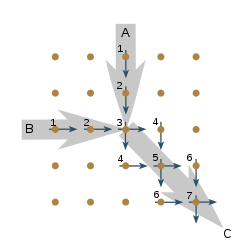Calculating Space
Calculating Space (German: Rechnender Raum) is Konrad Zuse's 1969 book on automata theory. He proposed that just as chemistry could, in principle, be reduced to physics, so could physics be reduced to theoretical computer science.[2] Zuse proposed that the universe is being computed by some sort of cellular automaton or other discrete computing machinery,[2] challenging the long-held view that some physical laws are continuous by nature. He focused on cellular automata as a possible substrate of the computation, and pointed out that the classical notions of entropy and its growth do not make sense in deterministically computed universes.

Bell's theorem is sometimes thought to contradict Zuse's hypothesis, but it is not applicable to deterministic universes, as Bell himself pointed out. Similarly, while Heisenberg's uncertainty principle limits in a fundamental way what an observer can observe, when the observer is himself a part of the universe he is trying to observe, that principle does not rule out Zuse's hypothesis, which views any observer as a part of the hypothesized deterministic process. So far there is no unambiguous physical evidence against the possibility that "everything is just a computation," and a great deal has been written about digital physics since Zuse's book appeared.
See also
References
- Rechnender Raum (PDF document), Elektronische Datenverarbeitung, 8: 336–344, 1967.
- Mainzer, Klaus; Chua, Leon (September 2011). The Universe as Automaton: From Simplicity and Symmetry to Complexity. Springer. p. 6.
- Konrad Zuse, 1969. Rechnender Raum. Braunschweig: Friedrich Vieweg & Sohn. 70 pp.
- --------, 1970. "Calculating Space", MIT Technical Translation AZT-70-164-GEMIT, Massachusetts Institute of Technology (Project MAC), Cambridge, Mass. 02139. Adrian German and Hector Zenil (eds) re-edition in LaTeX with permission of MIT and Zuse's family, 2012
- Jürgen Alex: Rechnender Raum, in: Drsb.: Zur Entstehung des Computers - Von Alfred Tarski zu Konrad Zuse [ ... ] - Tertium non datur, VDI-Verlag Düsseldorf 2007, SS. 251 bis 279, ISBN 978-3-18-150051-4
External links
- Jürgen Schmidhuber's site Zuse's book and 1967 paper.
- Calculating Space - a painting by Zuse - Konrad Zuse's visualization of the idea
- Web article and simulation of such a calculating space in C and LIBPNG GERMAN
- SecondSpace Simulation of waves within a 2D space (time and space are discrete), similar to FDTD. An OpenCL graphic card is needed.